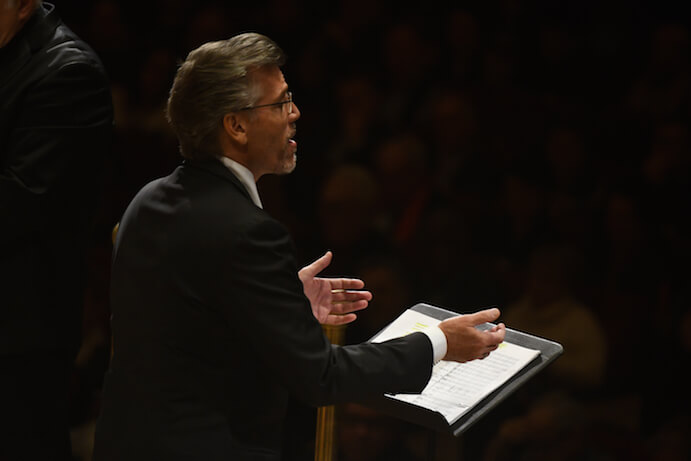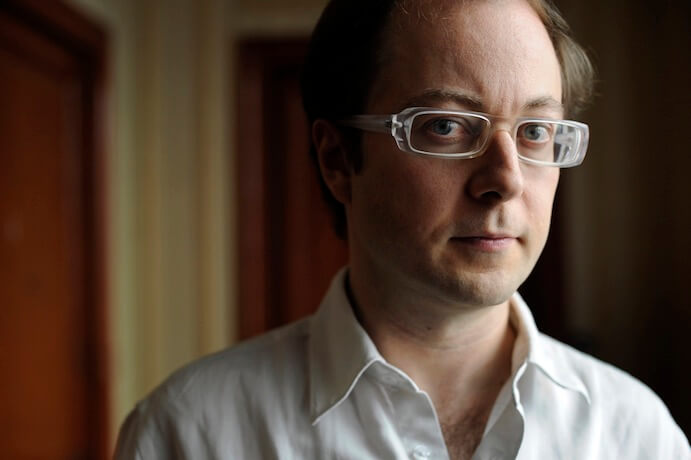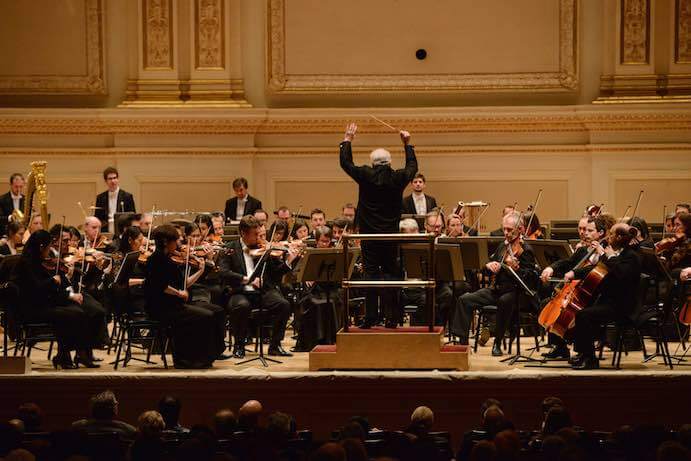The Orchestre National de Lyon’s last American tour took place in 2003, and their highly-anticipated return to the Carnegie Hall stage on February 20, 2017 did not disappoint. Under the baton of Maestro Leonard Slatkin, the Orchestre National de Lyon presented a thoughtfully-crafted program of exotic masterpieces by Ravel alongside the U.S. premiere of Guillaume Connesson’s thrilling symphonic poem Celephaïs.
The first half of the evening was dedicated to Ravel’s Antar, a suite composed after a work of the same name by Nikolai Rimsky-Korsakov. The Orchestre de Lyon’s presentation of the work was a powerful testament to the intersection of scholarship, musicality, and innovation. Ravel was greatly moved by the kuchka (Russia’s most prominent 19th century composers known as the “Mighty Handful”) as well as exotic fantasies spurred on by a trip to the 1889 World’s Fair. He took Rimsky-Korsakov’s Antar music alongside some of his other works and created new orchestrations to serve as incidental music for a play of the same name by the French-Lebanese writer Chekri Ganem in 1910. Unpublished, it was not performed for over a century when it was reconstructed by the Orchestre de Lyon, who ingeniously commissioned the French-Lebanese writer Amin Maalouf to compose a dramatic text that would be spoken by a narrator to accompany the music. That version of Antar was first performed in France in 2014. For their performance in New York, the Orchestre employed a vivid and beautiful English translation by Matthew Hurt and Sarah Vermande.
Musically speaking, Ravel’s Antar is a masterpiece of sound that does not pale in comparison to his other more famous works. The piece is filled with sumptuous cello lines, longingly impassioned solo interjections, great swells of sound that depict armies in battle, and tender and intimate moments for the lovers. As the drama unfolded, the music shifted from triumphant and boisterous interludes with thunderous percussion, tremolos, and lush melodic lines to quietly restrained moments that drew bursts of exotic and lamenting melodies from the principals. This was the ideal work for the Orchestre de Lyon to bring to life. In addition to their tremendous precision, the musicians of the Orchestre under Slatkin’s expert direction responded immediately to the constantly shifting moods and displayed an unparalleled ability to capture the entire drama–the extreme highs and lows of the tale of the warrior Antar–in their playing.

Thomas Hampson and the Orchestre National de Lyon–Photo by Pete Checchia
Additionally, one could not hope for a better narrator than Thomas Hampson, who displayed all of the characteristics that make him one of the foremost American baritones of today. Imposing and refined in both manner and speech, his diction was impeccable to the point that the printed text was virtually unnecessary. Hampson’s lifetime of dedication to art song was apparent as he deliberately and dramatically delivered the lines of the story while subtly adapting his voice to suit each character. He equally embodied the personalities of the young and battle-eager Antar and the reproachful, loving Abla. In the final scene following Antar’s death, his delivery of the words, “…take comfort. Death too is a mirage” captured the visceral feelings of great joy and unyielding sorrow of one who has felt pure love and happiness but then lost everything to tragedy. One can only hope that Ravel’s Antar receives many more performances by the Orchestre National de Lyon, ideally with Thomas Hampson in the role of Narrator.
Composed in 2016 for the Orchestre National de Lyon and the Nederlands Philharmonisch Orkest, Guillaume Connesson’s Celephaïs is an exciting work based on the mythological writings of American author H.P. Lovecraft, and it served as a fitting companion piece to an otherwise all-Ravel program. This symphonic poem is comprised of five connected sections linked by a common musical theme and depicts a journey to an imaginary city. Like Ravel, Connesson’s writing is brilliantly colorful with shimmering passages for the strings, a wide array of sound including soaring legato melodies, precise pizzicato sections, tremendous crescendos, undulating percussion, and crashing cymbals. Celephaïs was very well-received by the audience and rightly so.

Guillaume Connesson
Another highlight of the evening was Ravel’s Shéhérazade featuring the acclaimed soprano Renee Fleming. This cycle of songs is demanding both musically and dramatically and as expected, Fleming confidently met the challenge with her characteristic grace and poise. Her full lyric soprano spun out gentle lines of beauty and her voice was as silky as ever from the bottom to the top of her range. Her cries of “Asie!” were especially glorious and cut through the hall. Slatkin and the Orchestre deserve significant praise as well, particularly in maintaining a balanced sound and never overpowering the singer, even in the lower sections where this is often the case.
The Orchestre National de Lyon ended their concert with Ravel’s 1913 masterpiece Daphnis et Chloe Suite No. 2. Originally composed to accompany dances for Serge Diaghilev’s Ballets Russes, this iconic and vibrant work embodied the sort of music that this ensemble does best and served as a fitting work to celebrate the orchestra’s triumphant return to the United States.
After a thunderous standing ovation, two encores were offered: Offenbach’s charming “Barcarolle” from Les Contes de Hoffmann and Felix Slatkin’s jaunty work Carmen’s Hoedown complete with cowbell and rodeo-style yips. It was a lighthearted and masterful end to a splendid evening.





















